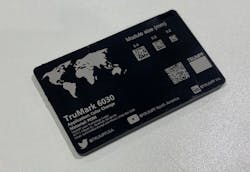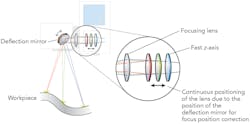JACK PENNUTO JR.
Laser marking for identification and traceability is the alternative to traditional marking solutions.
With an increased range of laser parameters, functionality, and wavelengths, laser marking has evolved to efficiently displace traditional mechanical and ink methods. Examples of this include deep engraving of gears or marking castings instead of using dot peening (FIGURE 1). With flexibility and performance unmatched by other technologies, the parameters of a single laser can be easily adjusted for contact-free, high-contrast marking or surface cleaning.
Laser marking background
Laser marking continues to increase, being fueled by the growing need for product traceability, the increase in the amount of marked data per item, and the awareness of laser marking as an alternative to other marking methods.
Effectively adjusting the laser’s optimal pulse energy and peak power balances the fluence for melting against the irradiance for ablation. Choosing the optimal wavelength influences both how the light couples to the marking surface and how significantly the surface reacts. While many laser markers still use a source in the infrared (IR) range, commonly carbon dioxide (CO2), diode-pumped solid-state (DPSS), or fiber, there are increasing options available in the green and ultraviolet wavelengths to more efficiently mark organic or highly reflective surfaces where an IR laser may not be as productive. In addition to the wavelength, the laser’s pulse energy, pulse duration, and repetition rate all must be considered for a productive marking process. With all these parameters to consider, the mark optimization task can seem daunting. The good news is that advanced marking software can quickly run through these parameters to make this selection quick and easy.
For metal marking applications, solid-state laser markers in the nanosecond range produce an annealed mark where thermal-driven oxide grown produces a color change. For specialized applications such as matte black marking of medical instruments, ultrashort-pulse (USP) laser markers produce a laser-induced periodic surface structuring (LIPSS) process for a non-thermal material interaction. The processing parameters for LIPSS are greatly expanded with resulting marks highly resistant to fading during hundreds of autoclave sterilization cycles.
Despite the growing availability of lasers in the visible spectrum and the resilience of USP laser marks, the economics of IR nanosecond laser marking systems, particularly fiber lasers, with their broad range of pulse energies and repetition rates, have retained a significant portion of the laser marking marketplace. Recent developments in technology are supporting the expansion of laser marking to efficiently address more applications.
Part identification is the most common application for any type of marking. When compared to inkjet printers, lasers have clear advantages of being more permanent, not requiring a curing time, and eliminating a consumable. For both technologies, the surface to be marked typically needs to be flat (two-dimensional), to ensure the label sticks or the ink or laser is readable. Laser equipment to accomplish two-dimensional marking is straightforward, as the marking field remains within the focal plane for highly repeatable results.
Marking gets complicated
But what about marking non-flat (three-dimensional) parts or those with significant contours? Two such marking applications are aluminum castings and steel powertrain parts. Dot peening has been the go-to solution to engrave such components because the process is relatively inexpensive, can withstand the typical casting and machining environments, and is sufficiently readable to fulfill the need.
Laser anneal marking is a good option for automotive engine components. It does not build up in the material, so it is not a dimensional issue. Plus, with the presence of lubricants, the annealed marked can remain readable in the future. On the other hand, engraving is needed for marking on a green gear, so the identification withstands subsequent heat treating and grinding steps. Why has laser engraving not had a bigger impact in this area? The answer to this question is cycle time. Lasers have historically been slower than mechanical engraving incumbents.
Recent higher-power, more-flexible laser markers are now challenging and winning against traditional mechanical engravers. “On an aluminum casting, for example, the high peak power of the laser creates a rough, black surface. And then running a low-power, high-repetition-rate cleaning process smooths out the surrounding surface and produces a brighter contrast,” says Florian Kiefer, Application Manager at TRUMPF Laser Technology Center. “And with that you get a contrast which is impossible to get with dot peening.” In addition to higher contrast, the readability of the black-engraved laser mark is consistent, as unlike dot peening markers, there is nothing to wear out. When considering the capital investment, the higher cost of the laser can be offset by eliminating consumables, associated maintenance time, and by using less expensive vision systems, since the black engraving is more consistent and inherently higher contrast (FIGURE 2).Conclusion
With technology available today, laser marking is expanding into contoured surface applications that have predominantly used mechanical methods for marking and engraving. Flexible marking lasers can deliver high peak power and consistent power level across the entire repetition rate range. With such a system, anneal marking, cleaning, and black engraving can all be accomplished effectively. Extending the laser’s capability by coupling it with effective 3D marking software enables the engraving of data matrix code on uneven surfaces, such as on castings, to eliminate image distortion so the vision system camera can consistently read and identify the part as it moves through the manufacturing process. By increasing the awareness of the laser technology and advanced marking software, the adoption of laser marking will continue to grow.
JACK PENNUTO JR. ([email protected]) is Director of Sales at the TRUMPF Laser Technology Center, Plymouth, MI; trumpf.com.


